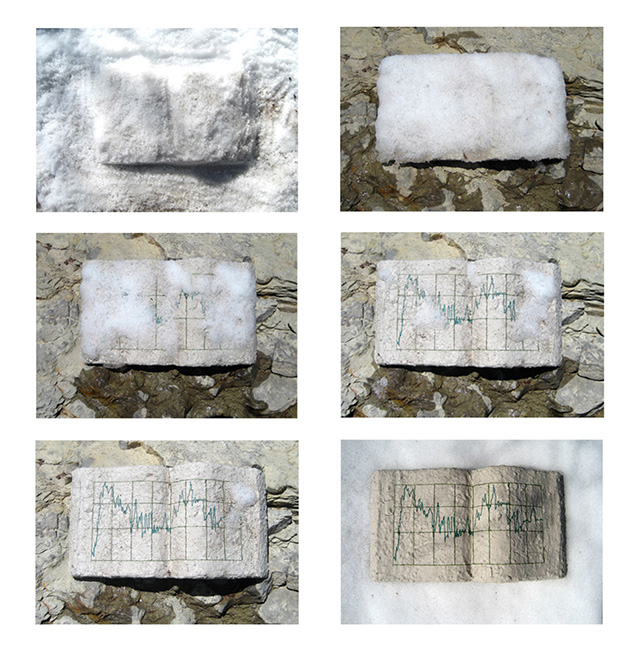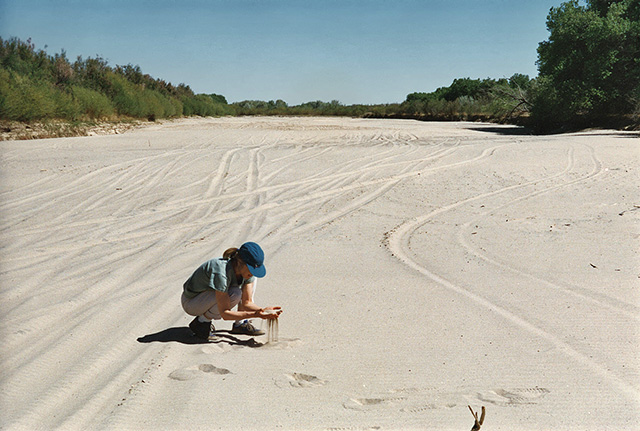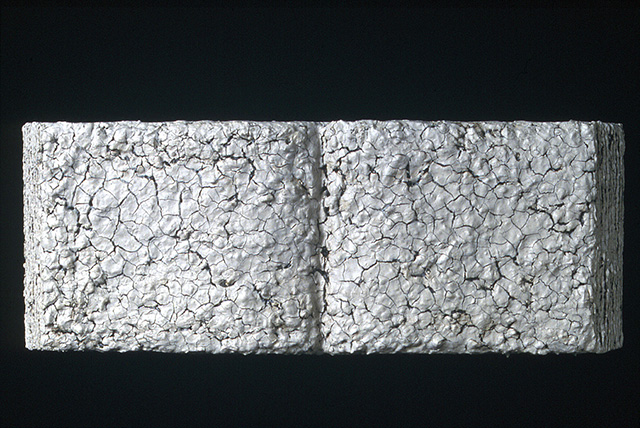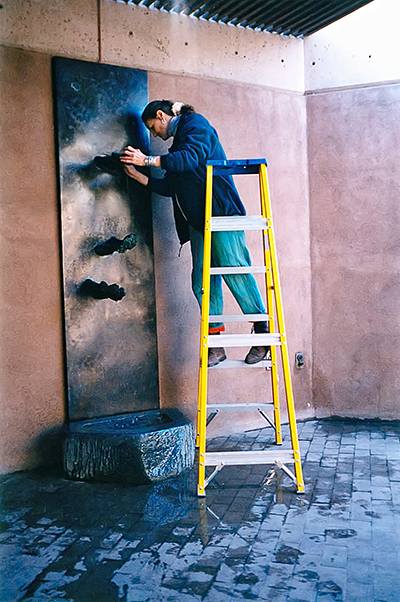As a journalist and author covering anthropogenic climate disruption (ACD), when I write about what is happening in the liquid realms of the biosphere, my focus tends to be on how rapidly certain parts of the cryosphere are melting. Additionally, sea level rise, thermal expansion of the oceans, floods and droughts are what tend to make it into my Climate Disruption Dispatches and my book.
Hence, I, like most of us, tend to overlook the most blatantly obvious place where water is present … my own body.
But when I interviewed Fulbright Scholar, author, poet, sculptor and installation artist Basia Irland, she began her observations about water in exactly this location: our interior physical worlds.
“One cannot discuss water without first emphasizing interconnections,” Irland explained to Truthout.
Irland blogs for National Geographic about various rivers, writing each post from the perspective of the river itself. She sees human bodies as bodies of water, too.
“We are water,” she said in our interview. “Our bodies house streams: lymph, bile, sweat, blood, mucus, urine. Water enters, circulates, leaves — individualized hydrologic cycles. Each of us is a walking river, sloshing down the hallway with damp innards held together by a paper-thin epidermis.”
I, like most of us, tend to overlook the most blatantly obvious place where water is present … my own body.
Irland, along with lecturing and exhibiting extensively, is professor emerita at University of New Mexico, where she founded the school’s Art and Ecology Program. She also works with scholars from diverse disciplines building rainwater harvesting systems; connects communities along the entire length of rivers and fosters dialogue among them; films water documentaries; sculpts hand-carved ice books embedded with native riparian seeds for river restoration projects; and creates waterborne disease projects around the world to heighten awareness.
To see more stories like this, visit “Planet or Profit?”
Irland reminds us that cycles of moisture connect us across distance and time. She points to Henry David Thoreau, who described laying down his book and going to the well for water. There he met an imaginary man drawing water for a Brahmin priest. Thoreau remarks how “our buckets, as it were, grate together in the same well. The pure Walden water is mingled with the sacred water of the Ganges.”
The same water the dinosaurs drank circulates in our bodies. The artist’s wet breath mixes with moisture exhaled by aspen trees, river otters, blue herons and ravens.
Another way to view this bond comes from theoretical high-energy physicist and author Fritjof Capra, who has written about the basic oneness of the universe as a central characteristic of both modern physics and the mystical experience. He writes in The Tao of Physics, ” … the constituents of matter and the basic phenomena involving them are all interconnected, interrelated, and interdependent; that they cannot be understood as isolated entities, but only as integrated parts of the whole.”
For Irland, the hydrologic cycle is a perfect example of this inherent interconnectivity.
“Clouds gather overhead, conferring about how soon to release their moisture,” she said. “Slow, steady rain builds to a crescendo. Winds blow. Temperatures drop. Snow accumulates. Months pass, and the frozen elements melt, trickling toward a river, flowing out to sea, eventually evaporating to re-form the cloud committee, and the hydrologic cycle continues its primeval rhythms, as it has for eons. The same water the dinosaurs drank circulates in our bodies. The artist’s wet breath mixes with moisture exhaled by aspen trees, river otters, blue herons and ravens.”
The Magic of Water
Earth’s total water supply — the same supply that was here 3 billion years ago — remains relatively constant. Irland explained that it has been recycled over and over through evaporation, condensation and precipitation, yet gets redistributed, causing floods in certain regions, and drought in others. She notes that nature’s vast cycles are thousands and millions of years in duration, whereas our human cycles are relatively brief and short-sighted. We often upset the equilibrium in a water system.
“In our hubris, we build houses in a floodplain and then get angry at a river for doing what it does naturally, which is to flood,” she said. “Our response is to channelize the river, dam it, straighten it, make it behave as we wish it would. We try and dominate the waters of the world, but, ah-ha, nature always gets the last laugh.”
As an example, she pointed to how California has suffered a long drought, and then, at least temporarily, the rains returned, causing rivers to crest their banks and dams to reach a breaking point.
We try and dominate the waters of the world, but … nature always gets the last laugh.
Meanwhile, we cannot survive without water. While a human might carry on for three to four weeks without food, most of us would be gone in just a few days without water.
The greatest civilizations in history were nurtured by rivers, from the Tigris and Euphrates in what is now Iraq, to the Indus in Pakistan, to the Yangtse and Yellow Rivers in China, to the Nile of Egypt.
Phillip Ball, in his book H2O: A Biography of Water, wrote, “The fundamental nature of this dependence on water is reflected linguistically in Persian, in which the first word of the dictionary is ab, meaning ‘water.’ Herein lies the root of the word ‘abode’…. Quite literally, water constitutes the beginning of civilization.”
When I asked Irland about the role of water in why humans are here, she replied,
“I will simply quote one of my favorite authors, Loren Eiseley: ‘If there is magic on this planet, it is contained in water.'”
Dehydrated Life
 “Hydrogrid.” Carved wooden book coated with earth. The graph depicts stream flow on a specific date in Boulder Creek, Colorado. This line, similar to a heartbeat, can sometimes flatline as a stream dries up and dies. (Photo: Basia Irland)
“Hydrogrid.” Carved wooden book coated with earth. The graph depicts stream flow on a specific date in Boulder Creek, Colorado. This line, similar to a heartbeat, can sometimes flatline as a stream dries up and dies. (Photo: Basia Irland)
“In the desert, water in any amount is a tincture, so holy that it will burn through your heart when you see it.” —Craig Childs, The Secret Knowledge of Water
If there is magic in water, there is also significant danger in its disappearance. Water scarcity is projected to affect at least 40 percent of the global population by 2030, according to the World Bank.
Drought plays a central role in Irland’s work.
“I am fascinated by the notion of anhydrobiosis, which is essentially dehydrated life,” Irland explained. “Certain aquatic desert organisms cope with very long periods of drought, even up to a hundred years, by shriveling up until there is no water left in them.”
In so doing, their internal structures become crystalline. They become virtually dead — but can come back to life whenever a small amount of moisture falls on their bodies. This phenomenon has been compared to long-dormant seeds that, when finally planted in moist soil, begin to sprout.
“Oh, that we humans could do the same,” Irland said. “Drought, then, would not have the dire consequences on us. Dehydration, death and drought go together.”
She noted how in literature, drought is often used as a symbol of death, such as in T.S. Eliot’s poem “The Waste Land” and in John Steinbeck’s book The Grapes of Wrath.
Irland points out that storing and utilizing moisture that has fallen from the sky is an ancient tradition that is gaining renewed respect during this millennium in various locations around the globe. Collection systems dating back 4,000 years have been found in the Negev Desert of Israel. Rainwater harvesting entails the capture, diversion and/or storage of rain for irrigation or personal uses such as cleaning, or as a possible source of potable water.
“The projects I create redirect water from the roof through gravity-fed methods for xeriscape (low-water-use) gardens,” Irland explained. “Most of New Mexico, where I live, only receives about eight to ten inches of rain per year, and the groundwater levels have dramatically declined in some areas.”
Thus, the state’s rivers are running low because of excessive withdrawals that have depleted connected aquifers.
 Some years the Río Grande becomes a river of sand, with all the upstream water being diverted and overused. In 2017, it was flowing at the highest rate in decades due to record amounts of snowmelt coming from the upper mountain ranges. (Photo: Basia Irland)
Some years the Río Grande becomes a river of sand, with all the upstream water being diverted and overused. In 2017, it was flowing at the highest rate in decades due to record amounts of snowmelt coming from the upper mountain ranges. (Photo: Basia Irland)
Irland discussed the need to utilize harvested precipitation both for humans and plants and reminded us that any household anywhere can collect water simply by placing a large container underneath a gutter downspout.
“Rainwater harvesting methods are not widespread in America, but in some countries, such as Australia and the Middle East, rain collection is common,” she said. “Sometimes with our modern technology, a hesitancy to revert to traditional ways exists, even though time-tested methods can provide adequate solutions.”
Irland believes that as the global water crisis continues to worsen, if every new building were designed to redirect runoff toward gardens, and existing structures were retrofitted with simple rain catchment systems, we could conserve a lot of moisture.
The mountain glaciers that give birth to streams and creeks are drastically receding, and a lot of them will disappear altogether.
However, Irland is quick to add that it is important to design harvest systems that only momentarily hold the runoff, or redirect it, allowing the moisture to seep into the ground, where it will eventually make it back to the river system via shallow groundwater. In this way, the natural cycle of water is respected.
Sky Juice
Irland is also fascinated by the way languages from diverse cultures shed light on what water means to them.
One example she gives is how on certain Caribbean islands, rain is called “sky juice.”
“Just thinking about this phrase helps us look at rain in a new way,” she said. “People’s connection to the language of their place is important, so some of my rainwater project sites incorporate indigenous and international words for water.”
For her, these words are one way to ground each of us in the reality that water is a worldwide necessity, and its degradation, scarcity, or overabundance, as in the case of floods and tsunamis, can be problematic or disastrous for us all, wherever we live.
Conservation by way of the installation and use of low-flow showers and toilets, taking fewer showers, flushing only when necessary and turning off the tap when we brush our teeth are tactics that Irland hopes everyone will employ. Others include designing region-appropriate landscaping and gardening, and education via water fairs for communities, with a focus on children, whom she points out, are “the next generation to care for the waters of the world.”
In this way, according to Irland, people can become “intimately familiar with bodies of water in [their] area, and practice reverence and respect for all who share these waters.”
She pointed to many examples of water conservation that one can utilize. Vacuum toilets, similar to the ones in airplanes, use little water: wastes are kept in tanks and composted to produce bio-gas for fuel. Instead of paving our ground with impervious cement, porous roads and parking lots allow rainwater to recharge the aquifer. And because water is used in manufacturing consumer products, purchasing only what is necessary cuts down on water consumption.
You can use the Waterfootprintcalculator.org to see how much water is used in your sandwich, your clothes, or your gadgets.
Knowledge about and reverence for water has never been as important as it is today.
Irland has produced several projects that relate directly to drought. One of her short video pieces is entitled “Book of Drought: A Water Memory.” The liner notes for the CD cover read: “In many places around the world the memory of water is more tangible than the physicality of water itself. The implications of this are enormous, including a loss of crops, lack of clean water, and a huge increase in environmental refugees.”
 “Book of Drought.” Carved wooden book, dried mud, matte medium. (Photo: Basia Irland)
“Book of Drought.” Carved wooden book, dried mud, matte medium. (Photo: Basia Irland)The video begins with a quote from “The Waste Land” by T.S. Eliot. Next, the camera pans across mud cracks on the surface of an open sculptural book and we hear: “This book is constructed of parched field notes dry with dehydrated paragraphs preserving an arid script charting fluctuating droughts through past, present and future generations. The pages are chapped, brittle and sunbaked.”
Then the narrator goes on to list the devastating loss of crops across large swatches of Australia, Eastern Cuba, Nicaragua, the American Southwest, the Middle East, Central Africa, Asia and Haiti. Amazingly, 28,000 of China’s more than 50,000 rivers have gone dry due to over consumption. With ACD, the mountain glaciers that give birth to streams and creeks are drastically receding, and a lot of them will disappear altogether.
“Can we imagine a world with no rivers?” Irland asked.
A Biographer of Water
“Water needs many biographers, because in truth it is not a personality but more like a culture to itself, with laws, arts and a unique history and geography.” —Philip Ball, H2O: A Biography of Water
Irland has addressed drought through her art in many ways. For example, she has constructed small-scale rainwater harvesting systems. She was commissioned by the Albuquerque Museum to create a fountain, but she refused because it would have required using potable ground water. After a month, she called the museum director back and asked if she could put a stock tank on the roof of the museum. Much to her surprise, he said yes. The water flows from the tank to a set of cast bronze arms, modeled after her own arms, so the water drips from one hand to the next and then outside the museum to water plants. The only time this fountain works is when there has been moisture, thereby making the ecosystem where she lives visible. (See lead photo)
In another project, the University of New Mexico Student Union Building (SUB) was in the initial stages of being renovated. Irland met with the architect and asked him where the rain would be collected to feed xeric plants (plants whose habitat is very dry) on campus.
He told her they had not thought of this aspect of the building, and that all the roof water would automatically go into a storm drain system.
“We located a place at the northwest corner of the SUB where a drain could be installed on the roof to funnel any precipitation down to the ground level, thus watering a small garden,” she explained. “This water exits into an underground drip hose. If there is too much rain, it circumambulates the garden in a gravel swale, and then enters a drain that goes directly to the river.”
Thus, the pattern reminds people of the hydrologic cycle: Water comes down as rain, is utilized to feed the plants, flows to the river and on to the sea, evaporates to form clouds, and then the cycle begins again. An etched tile plaque at the site reads: “Harvested on the roof, scarce rainfall flows to a subterranean drip system. Overflow circles the xeric fragrance garden in a stone swale, and then drains to the Río Grande.”
Surrounding the garden is a wall of ceramic tiles with words for “water” in 63 languages, such as Wai, Nero, Agua, Eau, Pani, Amanzi, Paahu, Maji, Maille, Uisge, Akvo, Vann, Thuk, Bishan, Voda, Su.
In 2008 US hydrologists were warning that drought across the American Southwest had already become a “quasi-permanent condition.” By then, there was already a 50 percent chance that Lake Mead, the water supply to what amounts to the fifth-largest economy in the world (when you combine the economies of California, Nevada and Arizona), could run dry by 2021.
And it’s happening across the world as ACD and human development progress. Rivers are drying up. A 2009 study looking at stream flows on 925 of the world’s largest rivers from 1948 to 2004 found that twice as many of them were falling as rising. “During the life span of the study, fresh water discharge into the Pacific Ocean fell by about 6 percent, or roughly the annual volume of the Mississippi,” it reported, according to the Guardian.
Knowledge about and reverence for water has never been as important as it is today.
Irland’s art beautifully weaves in the critical threads of conservation and education, along with her reverence for water and its role in life and on Earth. Her work has set her apart as one of the liquid realm’s most eloquent biographers.
Perhaps each of us can contribute to the biography of water, becoming more conscious of its significance — and thereby dedicating ourselves to its conservation.
Join us in defending the truth before it’s too late
The future of independent journalism is uncertain, and the consequences of losing it are too grave to ignore. To ensure Truthout remains safe, strong, and free, we need to raise $47,000 in the next 8 days. Every dollar raised goes directly toward the costs of producing news you can trust.
Please give what you can — because by supporting us with a tax-deductible donation, you’re not just preserving a source of news, you’re helping to safeguard what’s left of our democracy.
